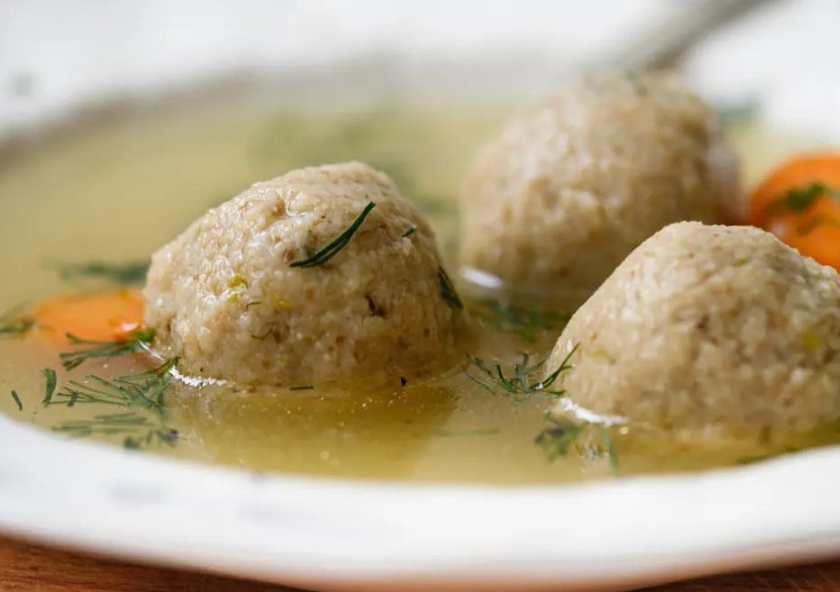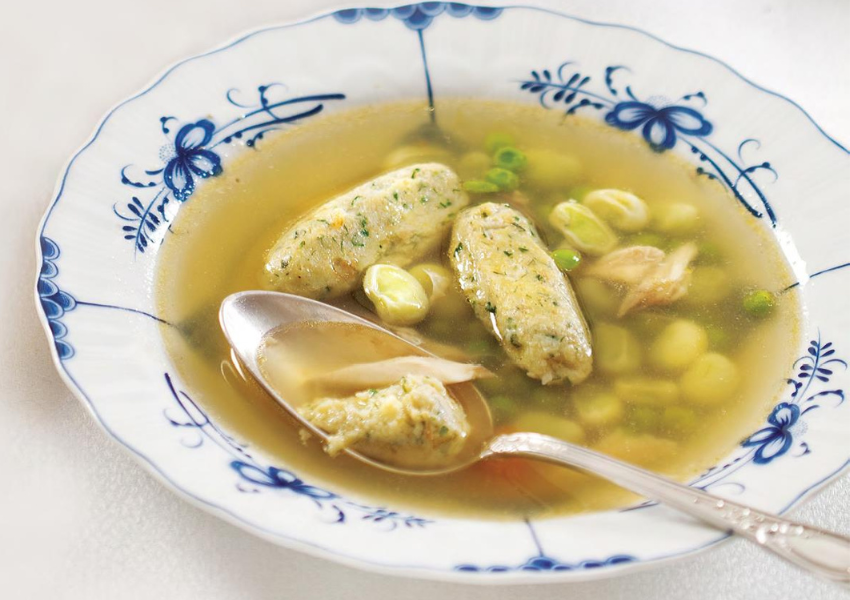Not Your Bubbie’s Chicken Noodle Soup
Thirty years of Al Hashulchan editor Janna Gur's tips, ideas, and techniques in one recipe
By Janna Gur
Published Mar 30, 2023

COURTESY LIZAPANELIM.COM
If you have visited Israel or have eaten in an Israeli restaurant, you know that the local food scene is predominantly Mediterranean and Middle Eastern, heavily influenced by Palestinian cooking as well as Jewish immigrant cuisines from the regions most close to us geographically (North Africa, Middle East, the Balkans). Ashkenazi cooking is much less popular, and often regarded as boring and bland. There are a few exceptions. Curiously, all of them are somehow associated with Shabbat or holiday cooking: challah, babka, cholent, and the most pervasive of them all, chicken soup.
From kibbutz dining halls to military canteens to hotel dining rooms and private homes, chicken soup is a mandatory item on the Friday night menu. Along with another Ashkenazi classic, kneidlach (aka matzo balls), this soup is also one of the stars of the Seder table, but if you take a closer look (or rather taste) you will discover that it is quite different from its Eastern European origins.
Classic Ashkenazi goldene yoich (golden broth in Yiddish) is made with onions, carrots, dill, and in some versions, a couple of celery ribs. The Israeli version is just as much about vegetables as it is about chicken, and the ingredients list will include most (if not all) of the following: carrots, onions, cabbage, pumpkin, leek, zucchini, parsley, and celery root, fennel, a whole tomato, and a hefty bunch of fresh herbs (parsley, dill, celery leaves, thyme, and even cilantro).
Jewish cuisines across the globe have an affinity for chicken soups. There is Persian gondi soup, vividly yellow chicken broth served with exotically perfumed dumplings made from ground chicken and chickpea flour. There is Yemenite chicken soup, which is similar in spirit to the Ashkenazi one, in that it has very few veggies, but these veggies are potatoes and onions and it is redolent with hawayij, the famous Yemenite spice mix. In Romanian chorba, the end result is very different from the classic chicken soup because there is a splash of vinegar and it is served with meatballs, but the vegetable combo (onions, carrots, cabbage, leeks, tomatoes, and lots and lots of parsley, dill, and celery) is quite similar. But of all ethnic Jewish chicken soups, the one that most closely resembles the Israeli version is Moroccan couscous soup. Pumpkin, leeks, cabbage, celery root, zucchini, and carrots are all there. The main difference is the addition of chickpeas and a pinch of either saffron or turmeric.
Moroccan cuisine was one of the first Jewish cuisines to affect mainstream Israeli cooking. The Moroccan community is one of the largest in the country, and many Moroccan Jews work in food service and hospitality. It is perfectly plausible that a hotel cook of Moroccan provenance would add a wider selection of veggies to the chicken soup pot, or that an Ashkenazi homemaker would add elements from her Moroccan neighbor’s couscous soup. This is exactly the kind of culinary interaction that gave birth to so many local classics, including what evolved as the vegetable-forward Israeli chicken soup.
Israeli Chicken Soup Recipe
(serves 10-12)
This recipe is the sum total of tips, ideas, and techniques I have picked up during my almost thirty-year stint as the editor of Al Hashulchan, the Israeli gastronomical monthly. It is deeply flavored and uplifting and works great as a dish in its own right or as a base for other soups, stews, or casseroles.
Ingredients:
2 lbs. (1 kg) chicken parts (especially wings) or 1 whole chicken
1 turkey neck cut into a few chunks
1 large bunch dill
1 large bunch parsley
5-6 stalks celery with leaves
3-4 sprigs thyme
1 large onion
3 carrots, halved
1 leek cut into large chunks
1 celery root, peeled and quartered
1 parsley root (or parsnip) peeled and halved lengthwise
2 zucchini cut into large chunks
1 fennel bulb, trimmed and quartered
1 lb. (450 g) pumpkin or butternut squash, cut into large chunks
1 whole tomato
1 teaspoon whole peppercorns
3-4 berries allspice
2-3 bay leaves
Salt to taste
Directions:
- Line the bottom of a large soup pot with half the herbs. Arrange chicken and turkey, as well as the vegetables, over the herbs and pour in about 4 quarts/liters of cold water. Add whole peppercorns, bay leaves, and allspice berries.
- Bring to a boil on medium-high heat, and patiently skim any foam that floats up the surface. Reduce the heat to low, and simmer partially covered for an hour and a half to two hours. If you plan to use the chicken for other dishes (salads or sandwiches), remove it from the soup after an 1 1/2 hour, so it retains its succulence.
- After the soup has simmered for about an hour, taste and add salt to your liking. If you are using a kosher chicken, you will need less salt.
- Tie the rest of the herbs in a bundle and add to the pot for the last 5 minutes.
- Cool the soup to room temperature, discard the herbs and strain. Keep the meat and any vegetables you might want to serve with the soup (especially carrots and zucchinis and pumpkin) in separate containers.

COURTESY JEWISH SOUL FOOD FROM MINSK TO MARRAKESH
Ashkenazi dumplings in North African Green chicken soup
Kneidlach with Fresh Herbs Recipe
(makes 20-25 dumplings)
This recipe, first published in my book Jewish Soul Food from Minsk to Marrakesh, comes from the kitchen of Hadassah Kavel, a Romanian-born Israeli who married into a Jewish Algerian family. In a typically Israeli way, her cooking is a blend of Ashkenazi and North African traditions. Hadassah inherited this recipe from her mother and improved on it by adding fresh herbs. At the family Seder meal, she serves the dumplings with North African green chicken soup, but it will work with any chicken soups you like to make.
Ingredients:
7 tablespoons vegetable oil
1 medium onion, finely chopped
1cup matzo meal
1 1/2 cups boiling water mixed
2 eggs, beaten
salt and freshly ground pepper
dash ground nutmeg
leaves from 6-7 sprigs each: parsley, dill, cilantro, finely chopped
Directions:
- Heat 4 tablespoons of oil in a skillet and sauté the onion over medium-low heat until deep golden, about 9 minutes. Set aside, with the oil.
- Put matzo meal in a bowl. Mix the boiling water with the remaining 3 tablespoons of the oil and pour it over the matzo meal. Whisk vigorously and cool slightly. Stir in eggs, salt, pepper, nutmeg, onion, and herbs. Cool to room temperature.
- Fill a large wide pot with water, add a teaspoon of salt to every liter/quart of water, and bring to a boil.
- With wet hands, form dumplings the size of a walnut (Haddassah prefers them torpedo shaped). Slide into the boiling water in 2-3 batches, don’t crowd the pot. Cook for 10 minutes. Serve in a piping hot chicken soup (3-4 balls per serving). You can also boil the matzo balls in the soup- this will make the dumplings more flavorful, but the broth will turn a bit cloudy.
Notes:
**Matzo balls are at their best if cooked on the same day (ideally up to 4 hours before the meal). But, if necessary, you can keep cooked dumplings in an airtight container in the fridge for up to 3 days.
Janna Gur is a Tel Aviv-based cookbook author, journalist, speaker, and culinary expert.
Reflections
Do you have a family recipe for the chicken soup and/or matzo balls? What makes it different from (or the same as) other chicken/matzo ball soups? Where does the recipe come from?
Have you tasted chicken soup in Israel? If yes, do you find its flavor different from the one you eat/cook at home?
Besides having matzo ball soup, what other Seder meal traditions does your family keep?
Want more?
Get curated JewishArts.org content in your inbox


